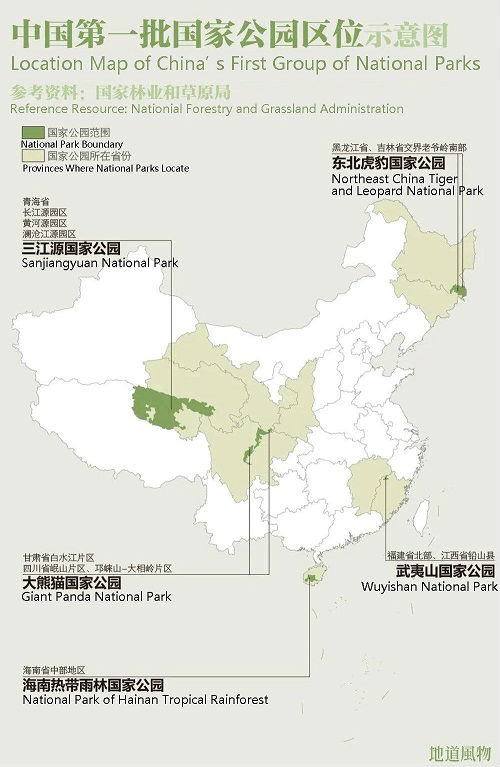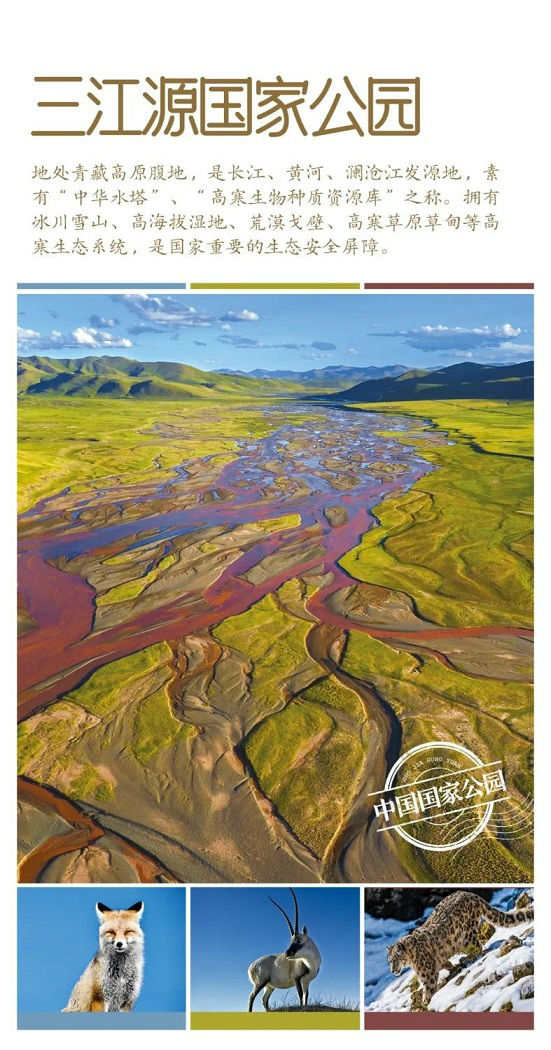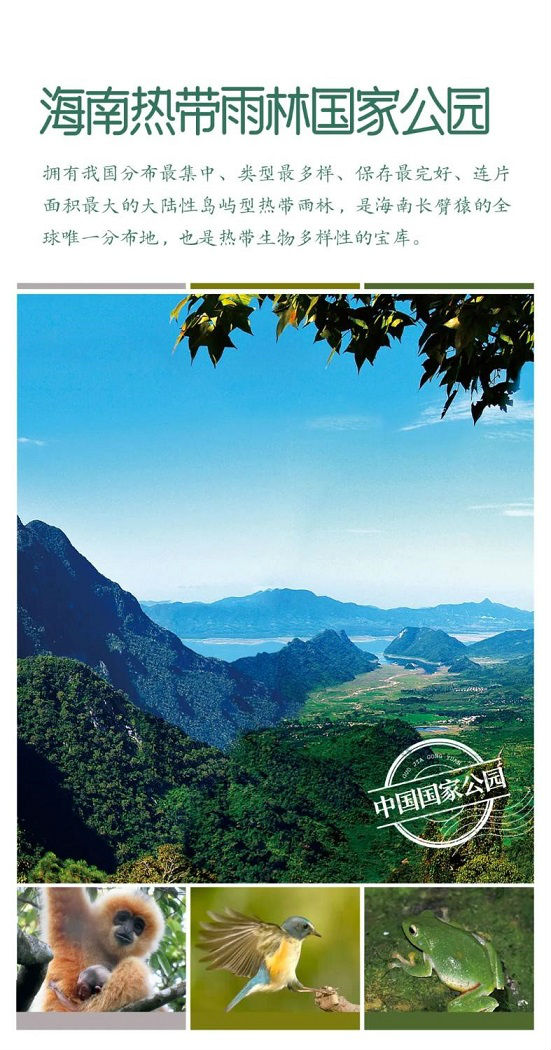

Ⅰ China Piloted the National Park System1
Since 1956 when the first nature reserve was set up, China has established close to 10,000 protected areas (PAs) of all types and at all levels, accounting for about 18 percent of its total land area. In recent years, it has built a PA system with national parks as the mainstay, supported by nature reserves and supplemented by nature parks, laying the foundation for protecting natural habitats, improving the eco-environment, and protecting ecological security in the country.
In 2015, China began to pilot the national parks system based on 60 years of experience with PAs. 10 trial national parks were established, covering a total area of 220000 square kilometers, or 2.3 percent of the total land area. The relevant PAs have been integrated into these national parks under unified management, comprehensive protection and systematic restoration. They showcase the best and most important parts of the country's ecosystems with unique landscape and diverse forms of life.
After years of trial run, the national parks have achieved remarkable results in setting up management systems, innovation operation mechanisms, strengthening supervision and administration, and coordinating development.
Ⅱ China Officially Launched First Group of National Parks
On Oct 12, 2021, Chinese President Xi Jinping announced the official designation of the country's first group of national parks while addressing the leaders' summit of the 15th meeting of the Conference of the Parties to the Convention on Biological Diversity (COP15). The protected land area of the national parks is 230,000 sq kilometers and cover nearly 30 percent of the key terrestrial wildlife species found in China2.
The five national parks (Figure 1), including Sanjiangyuan (Three-River-Source) National Park, Giant Panda national Park, The Northeast China Tiger and Leopard National Park, The Hainan Tropical Rainforest National Park, and The Wuyishan National Park, protect China's most valuable bioresources and ecosystems. They either protect the source of major rivers, harbor precious animal and plant species, or maintain the world's largest subtropical primordial forest ecological system in one latitude zone.
By building national parks, China intends to ensure good protection of these areas to keep natural ecosystems intact, demonstrate their value for the world, importance to the state, and role in enhance national identity, and leave precious natural assets to future generations3.

Figure 1 Location Map of China's First Group of National Parks [Source: https://www.huxiu.com/article/463269.html]
Ⅲ Introduction to China's First Group of National Park
1. Sanjiangyuan National Park

Figure 2 Pictures of Sanjiangyuan National Park [Source: National Park Administration website, http://www.forestry.gov.cn/main/586/20211012/201411612207597.html]
Location:Qinghai province in Northwest China
Total area:190700 square kilometers
Sanjiangyuan National Park is the first and biggest national park in the country. Sanjiangyuan, or "Three-River-Source", is where the Yellow, Yangtze, and Lancang rivers originate. The whole area provides more than 49 percent of the water discharge of the Yellow River, 25 percent of the water discharge of the Yangtze, and 15 percent of the water discharge of the Lancang. It is known as China's "water tower". The average altitude of the national park is 4500 meters above sea level. Its ecological system has been steadily improving in recent years, making it a habitat for rare animals and a gene pool of plateau life.
2. Giant Panda National Park

Figure 3Pictures of Giant Panda National Park [Source: National Park Administration website http://www.forestry.gov.cn/main/586/20211012/201411612207597.html]
Location: Sichuan, Gansu and Shaanxi provinces
Total area: 22000 square kilometers4
The habitats of giant pandas in China are scattered. The Giant Panda National Park holds more than 70 percent of the country's wild giant pandas. Aside from the giant pandas, the park is also home to highly protected animals, including the snub-nosed monkey. The national park of the animal will help connect loosely distributed reserves. The move will also promote genes flow of giant pandas between their different natural environments5. Earlier last year, giant pandas were downgraded from "endangered" to "vulnerable".
3. Northeast China Tiger and Leopard National Park

Figure 4 Pictures of Northeast China Tiger and Leopard National Park [Source: National Park Administration website http://www.forestry.gov.cn/main/586/20211012/201411612207597.html]
Location: Jilin and Heilongjiang provinces in Northeast China
Total area: 14,100 square kilometers
This national park locates in the central area of Asian Temperate Coniferous and Broad-leaved Mixed Forest Ecosystem. It has historically been home to large numbers of Siberian tigers and Siberian leopards and is the only area with permanent wild populations and breeding families. Siberian Tiger is one of the endangered wild animals; Siberian leopard is one of the most endangered large cat subspecies -- most of them living at the border of China and Russia.
In 1998 and 1999, only 12 to 16 wild Siberian tigers and 7 to 12 wild Siberian leopards lived in Northeast China. The number rose to 27 and 42, respectively, by 2014 after conservation efforts. According to the latest data, during the trial period, the number of wild Siberian tigers in the area increased from 27 to 50, while that of Siberian leopards increased from 42 to 606.
4. National Park of Hainan Tropical Rainforest
Location: in the south-central part of Hainan Island
Total area: 4,269 square kilometers
The national park has a forest coverage rate of 95.85%, covering more than 95% of the virgin forest and more than 55% of the natural forest on Hainan Island. It has the most concentrated, the best preserved and the most extensive tropical rainforest in China.
This ecosystem is home to a variety of species and serves as an important part of the world's tropical rainforest. As the most important ecological barrier for the island also called its "green heart", it has typical value for biodiversity protection in China and beyond. Hainan Tropical Rainforest National Park is one of the 34 biodiverse hotspots in the world. It is the ecological highland with the richest forest resources in Hainan, and also the only habitat for Hainan black-crested gibbons in the world.

Figure 5 Pictures of National Park of Hainan Tropical Rainforest [Source: National Park Administration website http://www.forestry.gov.cn/main/586/20211012/201411612207597.html]
5. Wuyishan National Park
Location: In Fujian and Jiangxi provinces in Southeast China
Total Area: 1280 square kilometers
Wuyi Mountain was selected as a pilot national park by the National Development and Reform Commission in June 2016.
The Wuyishan National Park features rich biodiversity due to its unique natural environment. Through years of protection, the forest coverage rate of Wuyi Mountain reached 96.72 percent. The area is currently home to a wide variety of wild animals and plants, including animals and plants under State class-one and class-two protection, such as white-neck long-tailed pheasants, silver pheasants, and Bretschneidera Sinensis7.

Figure 6 Pictures of Wuyishan National Park [Source: National Park Administration website http://www.forestry.gov.cn/main/586/20211012/201411612207597.html]
Notes:
1.Biodiversity Conservation in China. The State Council Information Office of the People's Republic of China. Oct.,2021. http://english.www.gov.cn/archive/whitepaper/202110/08/content_WS615fb228c6d0df57f98e1552.html
2.https://govt.chinadaily.com.cn/topics/travelandtourism/chinafirstnationalparks
3.http://en.people.cn/n3/2021/1015/c90000-9907555.html
4.http://www.forestry.gov.cn/main/5960/20200805/091649190599748.html
5.China advances construction of giant panda national park (shaanxi.gov.cn)
6.Northeast China Tiger and Leopard National Park officially launches (gojilin.gov.cn)
7.Wuyishan National Park (chinadaily.com.cn)
Source:
<http://english.www.gov.cn/archive/whitepaper/202110/08/content_WS615fb228c6d0df57f98e1552.html>
<http://www.chinadaily.com.cn/china/2017-09/28/content_32587759.htm>
<http://sjy.qinghai.gov.cn/about/gk/16606.html>
<http://hubaogy.cn/index/news/show/id/47.html>
<http://en.hntrnp.com/news/list-315.html>
<http://wysgjgy.fujian.gov.cn/gygk/>
Edited and translated by Bao Lianying